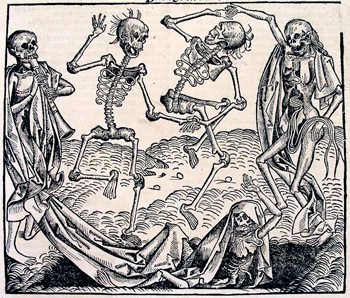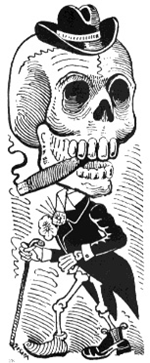Calaveras literally means "skulls". Calaveras are poems recited for the Day of the Dead (All Souls Day) in Mexico. They’re satirical poems that poke fun at people in a way that suggests they’re dead, even though they’re alive. Often the people being satirized are politicians and other people in power or in the public eye. It’s a way to make fun of the rich and powerful in a safe, accepted way. Also, to point out that we all end up in the same place in the end.
Sometimes these satires are found in the form of illustrations like the one below.
Días de los Muertes by Jose Guadalupe Posada
The tradition of these types of satirical poems dates back over 500 years. They could be found in Spain and other parts of Europe. They were often part of the "Dance of Death" (called the "Danse Macabre" in French and "Danza Macabra" in Spanish and Italian). The Dance of Death was a type of play performed in the 14th century.
The Dance of Death was also meant to remind people that everyone’s mortal. No matter what your station in life everyone faces the same fate. Given the frequent famines and plagues in Europe, people needed satire to help deal with the grim world around them. Poems, plays and paintings helped give people an outlet.
 The Dance of Death by Michael Wolgemut (1493)
The Dance of Death by Michael Wolgemut (1493)
Nowadays in Mexico ordinary people also write Calaveras for each other. Some even print them in the classified section of the papers around the Day of the Dead. They point out the shortcomings of people, but are meant to be taken in the spirit of fun.
Below you can read a calavera in Spanish with a loose English translation. It’s from here. It’s making fun of a Bullfighter:
Al torero
Aquí yace un buen torero,
que murió de la aflicción
de ser mal banderillero*,
silbado en cada función;
ha muerto de un revolcón
que recibió en la trasera,
y era tanta su tontera
que en el sepulcro ya estaba
y a los muertos los toreaba
convertido en calavera.Bullfighter
(English Translation)Here lies a good bullfighter,
Who died of grief
From being a bad banderillero*,
Booed at each performance;
He has died of a tumble
Received on the rear
And such was his foolishness
That he was already in the tomb,
Turned into skull and bones**
And fighting the dead.*Banderillero: A bullfight itself has stages. The Banderillero is the guy who plants the banderillas (flags) above the bull’s shoulders during a bull fight (see photo). There’s no translation for it in English. You can be a good bullfighter but a bad banderillero.
**In other words, he was already dead. “Calavera” normally means “skull”. But sometimes, when you say someone has become a “calavera”, it means this person has become only bones.
Translated by Lisa and Monique
Calaveras can also be poems talking about death in general and skulls and skeletons.
I hope you enjoyed learning about Calaveras, whether you’re alive or dead!
Mama Lisa
Additional Reading: Calaveras mexicanas in Spanish only
Calaveras and Posadas
This article was posted on Wednesday, January 26th, 2011 at 8:45 pm and is filed under Arts and Crafts, Calaveras, Countries & Cultures, Customs and Traditions, Danse Macabre, France, French, Hispanic Traditions, Holiday Poems, Holidays Around the World, Illustrations, Italian, Italy, Mexico, Poems, Poetry, Souls Day, Spain, Spanish, Spanish Poems, The Day of the Dead, The Day of the Dead Poems. You can follow any responses to this entry through the RSS 2.0 feed. You can skip to the end and leave a response. Pinging is currently not allowed.


























May 5th, 2011 at 10:21 am
Hola!
I was wondering about a Dia De Los Muertos song I heard years ago. It’s about an iguana (the iguana king?) who travels on a trail of chrysanthemums from people’s homes to the graveyard and then goes into the underworld. In the underworld he sees a tree of babies not yet born. At one point his skin comes off and he too is a skeleton. Can you help me with this? Gracias!
May 5th, 2011 at 10:30 am
That sounds neat! Is it in Spanish?
October 28th, 2015 at 8:15 pm
hey nice poems i hope you do more. I like this web site you made, its cool. I hope yuo appreciate the day of the dead as much as I do
October 29th, 2015 at 10:11 pm
Ok fine mama lisa if you dont want to reply to my comment then ill just spam you everyday for 5 years! (scary background noise with thunder and lightning)
November 4th, 2015 at 12:13 am
I think the Day of the Dead is a really nice holiday Kenneth. Now no more scary music please! Lol
October 22nd, 2016 at 5:03 am
Hello Lisa! That’s a great article! Here I found another calavera literaria in english:
http://www.calaveras-literarias.com/calaveritas/calaveras-literarias-en-ingles/
Hope you like it!
The calavera in english:
Soon will be The Day of the Dead
Nobody in the class will survive
If they don’t think with their head
Looking for a way to stay alive.
In Mexico we have our traditions
We love to eat lots of beans
But if you want false superstitions
You better celebrate Halloween.
The calaverita in spanish:
Pronto será el Día de Muertos
Nadie en clase va a sobrevivir
Si no piensan con su cabeza
Buscando una forma de vivos seguir
En México tenemos nuestras tradiciones
Nos encanta comer muchos frijoles
Pero si quieres falsas supersticiones
Mejor celebra el Halloween.
October 26th, 2016 at 7:09 pm
the day of the dead is important for Mexican people.
October 26th, 2016 at 7:09 pm
I think this article is a great article
January 11th, 2017 at 10:26 pm
Excellent writing, did not know that I had almost 500 years this tradition in my beautiful Mexico, is for a job of my school and I hope to get an excellent rating with this information. Thank you very much.
March 17th, 2017 at 2:12 pm
Hi this is awesome thanks
December 14th, 2017 at 7:33 pm
Hi Lisa, that’s nice, it’s useful for my son’s homework. Thank you.
November 6th, 2021 at 3:54 pm
[…] Calaveras – Skull Poems & The Danse Macabre (mamalisa.com) […]